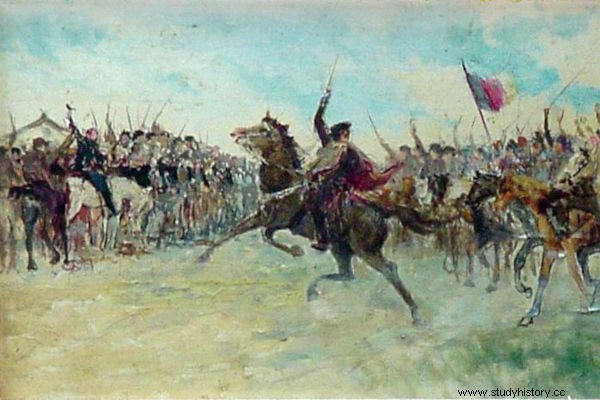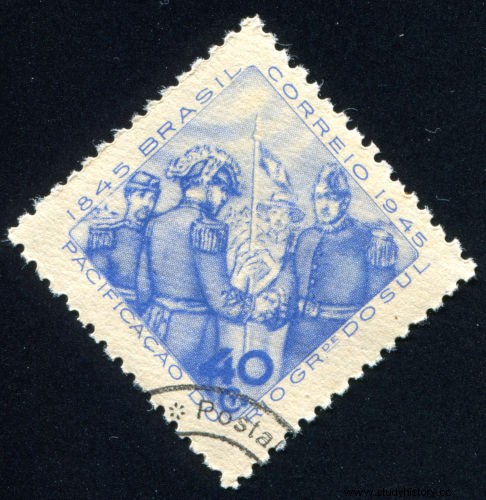The War dos Rags It was a conflict that took place in Brazil from 1835 to 1845. The revolt led by the Farroupilhas took on a separatist character in 1836 and was motivated by political and economic dissatisfaction in the province of Rio Grande do Sul. The outcome of this conflict was the signing of the Poncho Verde Treaty.
Access also :The main events of the Regency Period
Context:Rio Grande do Sul in the 19th century
The War of the Farrapos has its causes understood in the political context of the province of Rio Grande do Sul after the independence of Brazil. Firstly, the political centralization that was established in Brazil must be mentioned with the establishment of the monarchy. The lack of political autonomy displeased the elites of Rio Grande do Sul , because, in the Gaucho province, the circulation of ideas that defended freedom, sovereignty and federalism was considerable.

Along with these ideals was the defense of the republic, which It gained strength throughout the 1830s. The issue of political autonomy also included the requirement of the gauchos to appoint the governor of the province.
The dissatisfaction of the gauchos did not only exist in the political field, it was also present in the economic field. First of all, the gauchos did not agree with the determination of the Constitution of 1824 that gave the Empire powers to decide how much each province would pay in tax, but there was another question of greater impact.
The elite of Rio Grande do Sul was made up of ranchers and charqueadores, both cattle producers. The main product produced by them was jerked beef (dried meat), which was resold to the southeastern provinces as food, being distributed to slave workers. It so happens that, in the 1830s, there was a lot of pressure from São Paulo on Rio Grande do Sul due to beef jerky prices.
The Gauchos demanded the beef jerky tax reduction from 15% to 5% and still wanted the end of restrictions on the movement of cattle from Uruguay to Brazil (many of the gaucho ranchers had properties in Uruguay). The situation generated even more indignation in the gauchos, because Uruguayan and Argentine beef jerky had a tax rate considered low, which made the foreign product more attractive to the domestic market.
The imperial government still decided to impose a tax on the pasture league of each rancher and still refused to help ranchers in times of emergency. Finally, there were still high taxes on salt. Therefore, the dissatisfaction with political centralization and the high tax burden were the great motivators of the gauchos to rebel against the Empire.
Login also :War in Paraguay, the biggest conflict in the history of Brazil
The rags revolt
In September 1835, the gauchos decided to rebel against the Empire and the revolt began on September 20, 1835, when the insurgents gathered to attack the city of Porto Alegre. The rebellious gauchos wore clothes that were called farrapos and, therefore, they ended up known as “farroupilhas ”, a term that originally had a pejorative meaning.
The beginning of the revolt in Rio Grande do Sul did not exactly mean the separation of Rio Grande do Sul, since the Farroupilhas only announced the separation of the province on September 20, 1836, when the Rio-Grandense Republic was announced at the Jaguarão City Council. The first years of the conflict were favorable to the gauchos , which allowed them to expand the territories under their control.
Due to the success of Farrapos and their cause, the movement spread to the neighboring province of Santa Catarina. Between 1836 and 1839, the presence of farroupilha ideals grew considerably, especially in the coastal region where the city of Laguna was located. Inhabitants of Santa Catarina often acted as support points for the farroupilhas.
In July 1839, an armed force coming from Rio Grande do Sul by land and sea attacked and conquered the city of Laguna. After the city was conquered, the Juliana Republic was formed, which was federated to the Rio-Grandense Republic. The Farroupilhas even tried to conquer more territories in Santa Catarina, but were prevented by imperial troops.
The rule over Laguna lasted a few months and soon the city was reconquered by imperial troops. This event even coincided with a new moment of the conflict, because, between 1838 and 1839, the imperial forces gained strength in the war and began to progressively defeat the farroupilhas.
A series of factors help to explain the weakening of the rags and the strengthening of the imperial troops, which was consolidated in fact from 1842, when the Baron of Caxias was appointed as commander of the arms of the province of Rio Grande do Sul. The Baron reorganized his troops and won important battlefield victories.
The farroupilhas , in turn, began to face financial problems , many caused by the action of the Empire itself. Furthermore, the disagreements between the Farroupilhas themselves were enormous and, after years of the existence of the Rio-Grandense Republic, not even a Constitution had advanced.
Also, militarily speaking, the farroupilhas were in a very fragile position and as early as 1842, for example, they could not sustain major attacks against imperial troops. Therefore, at this stage of the war, they already adopted guerrilla tactics and avoided protracted confrontations with the imperial troops.
Login also :History of Elections in Brazil
Outcome of the Ragswart
The Barão de Caxias knew very well how to deal with the situation in Rio Grande do Sul and, mixing military attacks with diplomacy, took the Farroupilha leaders to the negotiating table. A agreement between Farroupilhas and the Empire took a long time to be sewn , but when finalized, it resulted in the Treaty of the Green Poncho , signed March 1, 1845.

The treaty ended the War of the Rags and ended the attempt at separatism. The two representatives who signed the treaty on each side were Barão de Caxias, on the imperial side, and David Canabarro, on the farroupilhas side. It is important to point out that, despite some terms being favorable to the gauchos, the Empire did not comply with all of them.
Among the terms contained in the treaty, we can mention:
- pardon the gauchos who had engaged in the revolt;
- the Farroupilha soldiers would be integrated into the imperial army, maintaining their ranks;
- slaves involved in the fight would be freed.
The government also met the great demand for rags, taxing foreign beef jerky by 25%, thus ensuring the competitiveness of the goods produced by the gauchos.
Image credits:
[1] Commons
[2] rook76 and Shutterstock
